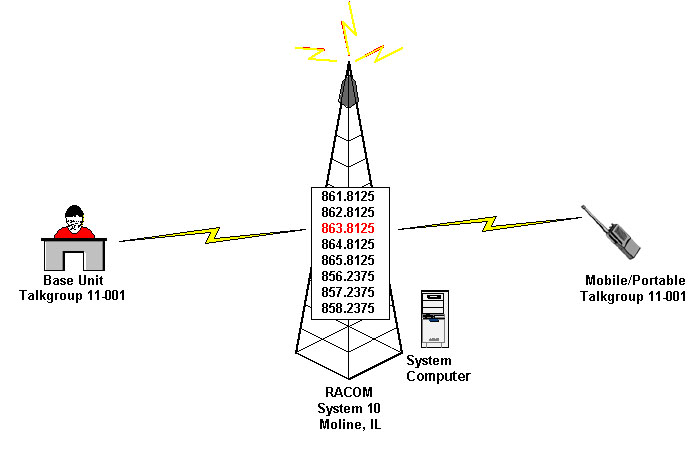
Quad Cities Scanning Home Page
On a conventional radio system, conversations between your local police department dispatchers and officers in the field are carried over a dedicated frequency. On a trunked system, the same conversations are carried over a set of frequencies. As stated on Motorola's Web site (http://ap.cgiss.motorola.com/products/radiosys/trunking.html): "Simply put, trunking permits a large number of users to share a relatively small number of communication paths - or trunks. Commercial telephone communication is a wireline version of trunking. This sharing of communication paths is managed automatically by a computer. Channel selections and other decisions normally made by the radio user are made by the central controller, a computerized switch. Channel assignment is automatic and completely transparent to the individual users."
The red frequency below represents the trunked system's data channel. It's from this channel that the computer allocates all traffic on the system. When the portable radio transmits, data is also sent to the computer, identifying the radio's talkgroup information. A talkgroup is an agency/fleet/sub-fleet set. An Ericsson EDACS talkgroup will look like this: 11-001. This is the Moline Police Department dispatch talkgroup. In this case, 11 is the agency, 00 is the fleet, and 1 is the sub-fleet. This data allows the computer to direct the traffic to only those radios that are part of the transmitting party's talkgroup.

The computer allocates an open system frequency (861.8125, for instance) to carry the portable's transmission to the other talkgroup members.
The next transmission on that talkgroup, whether it's a response from the base unit or a call from another portable/mobile, will follow the same process. The computer will allocate another open frequency for the traffic (864.8125, perhaps). Because all of the agency's radios are programmed to be part of this talkgroup, the user's aren't aware their transmissions are taking different frequency "paths" between points A and B and back.
For scanner hobbyists, traffic on these trunked frequencies can be received by a conventional scanner. However, such a conventional radio is unable to intelligently follow the conversations of a given talkgroup. If you hear a portable calling a dispatcher on 858.2375, you may not hear the dispatcher's response, as it will likely transmit on a different frequency: 856.2375, for example. You could program all of the system's frequencies into your scanner and manually flip back and forth, but it would take a lot of effort trying to catch every transmission in a conversation. You would also have no way of identifying which talkgroup you are hearing with any given transmission. Combine this with the fact that a system like RACOM's in the Quad Cities carries traffic from a large number of different agencies, and it become almost impossible to monitor in this way.
The solution to this problem? A trunking scanner.
By programming the necessary information into a trunking scanner (system type; logical frequency order, in the case of an Ericsson EDACS system, etc.), the radio will be able to lock in on the system's data channel and follow conversations. With each transmission, the talkgroup will appear in the scanner's display.
Two of the most popular radio systems are Ericsson EDACS and Motorola Type I/Type II. Each can be identified by the distinct sound of its data channel: Ericsson EDACS | Motorola Type I/II
|
Last Modified: 16-April-2004 Send Comments or Questions to: Jeff@Forret.org |